“The Asus ROG Strix Scar 17 is a solid gaming laptop, buoyed by the excellent AMD processor inside.”
- Chart-topping processor performance
- High-end gaming performance
- DLSS 3
- Decent value considering the hardware inside
- Solid port selection
- Lackluster screen
- Mostly plastic body
AMD has struggled for a few years to make the list of the best gaming laptops, but Asus’ new Strix Scar 17 might be an inflection point. Serving as a showcase for AMD’s most recent mobile platform, it is hands down one of the fastest gaming laptops on the market.
We’ve already seen Nvidia’s new RTX 4090 mobile graphics card in action, and the Scar 17 is a good showcase for the GPU. The real win here, though, is the AMD Ryzen 9 7945HX. It brings the scales back in balance in terms of flagship processor performance, finally allowing Intel and AMD to go toe-to-toe for the most powerful laptop chip on the market.
Asus ROG Strix Scar 17 (2023) specs
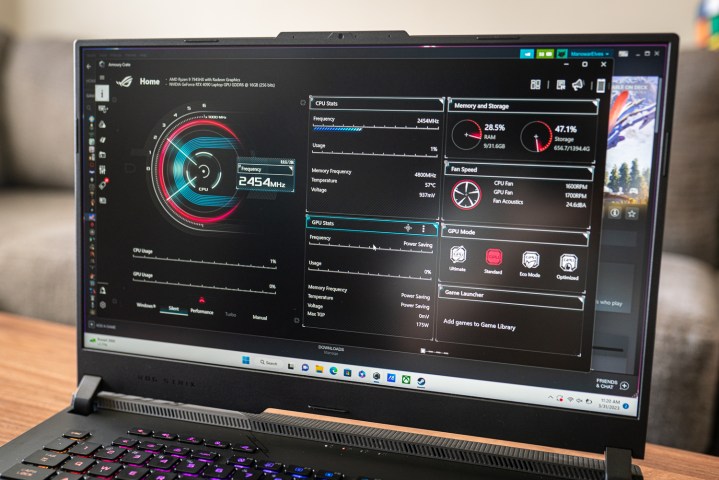
Asus onlyhas two models of the Strix Scar 17: one with an RTX 4090 and another with an RTX 4080. Otherwise, the two machines are identical. My review unit was the RTX 4090 configuration, but it’s worth noting that both graphics cards have access to 175 watts of power (150W for the GPU itself, plus 25W from Dynamic Boost).
The Nvidia GPU isn’t what’s exciting here, though. It’s AMD’s new Ryzen 9 7945HX, which is the company’s first 55W processo. It’s also the first 16-core mobile processor from Team Red, and it carries the distinction of debuting AMD’s Ryzen 7000 platform in laptops.
| Asus ROG Strix Scar 17 | |
| Dimensions | 15.55 x 11.1 x 0.92 inches |
| Weight | 6.61 pounds |
| Processor | AMD Ryzen 9 7945HX |
| Graphics | Nvidia RTX 4090 (175W TGP) |
| RAM | 32GB DDR5-4800 (support for up to 64GB) |
| Display | 17.3-inch, 1440p, IPS, 240Hz, G-Sync |
| Storage | 2TB PCIe 4.0 NVMe SSD |
| Touch | N/A |
| Ports | 1x HDMI 2.1, 2x USB 3.2 Gen 1 Type-A, 2x USB 3.2 Gen 2 Type-C (DisplayPort and power delivery), 2.5G Ethernet, 1x 3.5mm audio |
| Wireless | Wi-Fi 6E, Bluetooth 5.2 |
| Webcam | 720p webcam |
| Operating system | Windows 11 |
| Battery | 90 watt-hours |
| Price | $3,500 |
Otherwise, the specs are fairly standard for a high-end, 17-inch laptop released in 2023. You get 32GB of DDR5 memory with support for up to 64GB if you upgrade it yourself, along Wi-Fi 6E, Bluetooth 5.2, and a fairly mediocre webcam. That’s par for the course with most gaming laptops, unfortunately.
What stands out more is the price and size. Even at 17 inches, the ROG Strix Scar 17 isn’t unbearably large. It’s a a hair thicker than the Razer Blade 17 (and a bit heavier), but it doesn’t carry a massive heat sink like the MSI GT77 Titan. That’s a feat for a machine that’s mostly made of plastic.
The price isn’t terrible, either. While $3,500 is expensive for a laptop, the Scar 17 also features the highest-end components available today. It’s around $200 cheaper than the Alienware m18 with a similar configuration and $1,000 cheaper than the new Razer Blade 18. The RTX 4080 configuration isn’t bad, either; at $2,900, it’s the same price as Lenovo’s excellent Legion Pro 7i.
Flashy and smart

The Scar range from Asus features a more traditional design compared to other lines the company carries, such as the Zephyrus G14. Instead of the lid propping up the bottom of the laptop for better airflow, the Scar 17 has a stock clamshell design.
Originally, I was worried about thermals due to this design, but Asus has proven it has the situation under control. First, thick rubber feet on the bottom of the laptop help it stay lifted off whatever surface you’ve set it on. More importantly, the Scar 17 has a large intake vent on the back, which feeds air into the vapor chamber inside. Even with the stock Performance mode, the laptop stayed comfortably quiet during my testing, only ramping up to uncomfortable levels when pushed in its Turbo mode.
Selectable through Asus’ Armoury Crate app, the Turbo mode allows the Scar 17 to access a total of 230W of power — 55W for the CPU and 175W for the GPU. You can actually push the system further with the Manual mode, adding another 10W to the processor and putting a total of 240W of pressure on the vapor chamber. That’s a lot of power, but the Scar 17 handles it with grace. It’s a slightly lower power level than the MSI GT77 Titan, which pushes up to 250W of total power, but the Scar 17 delivers similar performance and has a much smaller heat sink.

The internal design is excellent, but the external look leaves a bit to be desired. It’s not bad, but it’s a far cry from the sleek, gamer-focused look Asus has established with machines like the Zephyrus M16. The top lid is adorned with an ROG logo, which is accompanied with an ROG badge spelled out on the two-tone heat sink. It looks good, but a bit unbalanced compared to the rest of the machine.
An RGB lightbar provides underglow in front of the machine, and there’s also RGB lighting on the keyboard. It focuses all of the lighting in front of the system, and I think the machine looks better with the lighting simply turned off. This comes down to personal preference, though.
Build quality is decent, but the Scar 17 doesn’t carry the “robust milled aluminum chassis” that Asus advertises. The external surfaces are almost entirely plastic, short of the lid, which has an aluminum cover. Even so, the Scar 17 doesn’t feel cheap. There was little flex in the keyboard, and although there’s a bit of wiggle in the screen, I’m not worried about it snapping off the two hefty hinges Asus has in place.
Great port selection, poor layout
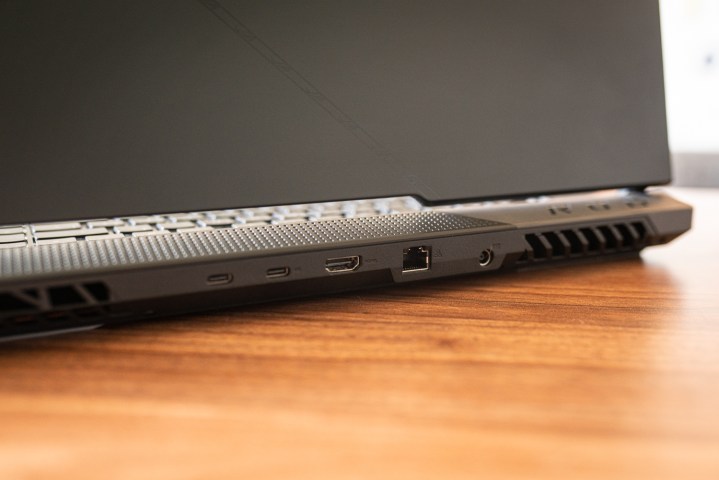
The Scar 17 has a solid port selection, but it doesn’t feel like Asus is using the space it has effectively. It adopts some design pointers from Lenovo by situating some of the ports around the back of the machine. That’s a good thing given the barrel charging cable, which awkwardly hangs off the side in Asus’ Zephyrus range.
Problems crop up with how the ports are split. The two USB-A ports are on the left side of the machine, while all of the other ports are on the back (including both USB-C ports). There’s not a single connection on the right side. It makes sense to have most ports on the left side, especially if you plan on plugging in an external mouse, but a single USB-C port on the right side would have been helpful.
The good news is that both USB-C ports come with DisplayPort mode, which combined with the full-sized HDMI 2.1 port, gives you a total of three display outputs so you can hook the machine up to one of the best gaming monitors. The USB-C ports include G-Sync support, too, which is great.
Scaling back on the screen
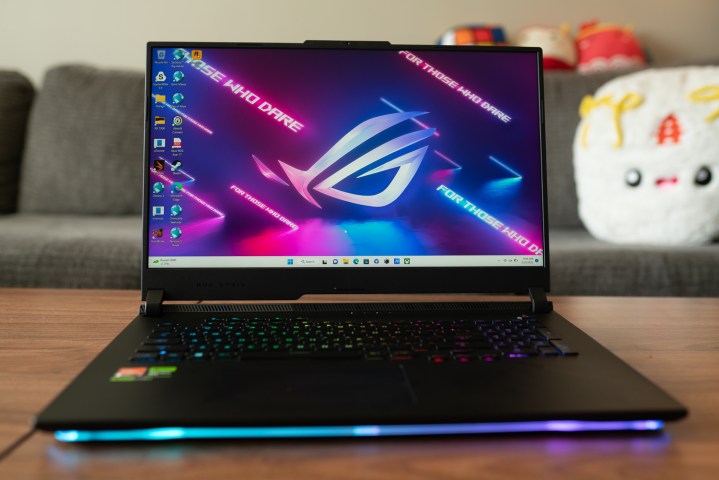
I was disappointed to learn that the Scar 17 doesn’t carry one of Asus’ new Nebula HDR displays. Instead, you’re getting a fairly standard IPS panel with unimpressive brightness (330 nits) and mediocre contrast (980:1 at most). It’s very color accurate, with a color error of less than 1, but it fails to deliver the cinematic HDR experience I’ve seen with machines like the Zephyrus M16.
It’s not a bad screen, though, just unimpressive. It still boasts a 1440p resolution and a 240Hz refresh rate. Most importantly, it’s certified with G-Sync. Between the refresh rate, G-Sync support, and solid color, it’s still a serviceable gaming display. It just didn’t floor me like some of Asus’ more recent Nebula HDR displays.
Keeping the keyboard simple

Asus has nailed a balance for its keyboard and trackpad, and the Scar 17 doesn’t change that formula. You get a satisfying membrane keyboard, fit with a slimmed-down number pad, along with several helpful function keys (including dedicated volume buttons). The Scar 17 is a joy to type on, and I’m glad Asus has stuck with its membrane keyboard over “mechanical” options on machines like the Alienware x17 R2. You can get per-key RGB lighting through Armoury Crate, as well.
The trackpad is fine, if a bit small. It’s offset to the left like on other Asus laptops, which I’m not a fan of. Your palm rests on the side when laying your fingers on the WASD keys. But the trackpad is very good at rejecting inputs from your palm. I continually rubbed my palm across the entire surface of the trackpad, and it didn’t pick up even the slightest input until I used my finger.
A win for AMD
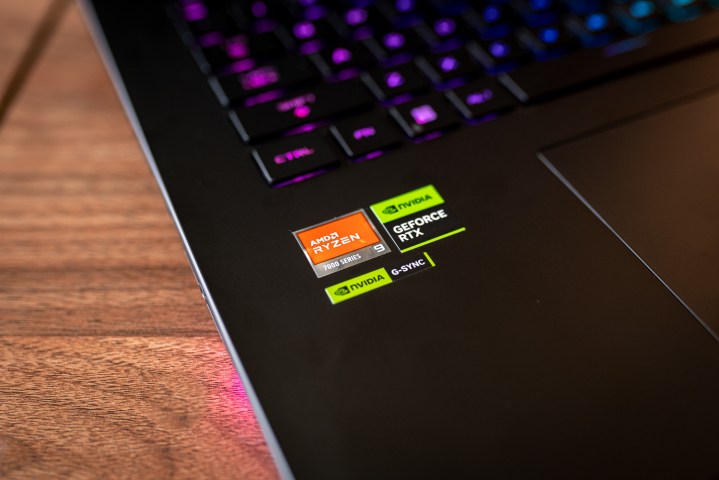
AMD isn’t messing around with its new Ryzen 7000 processors. The flagship Ryzen 9 7945HX inside the Strix Scar 17 is the fastest mobile processor I’ve tested, even managing to beat out Intel’s 24-core Core i9-13980HX across my suite of tests. That’s even when Intel’s processor is stuffed inside a massive laptop with a ton of cooling, such as the MSI GT77 Titan.
Compared to more modest machines like the Lenovo Legion Pro 7i, it’s not close. The Ryzen 9 7945HX trimmed 20% of time off transcoding in Handbrake, and offered better single-core and similar multi-core performance in Geekbench. It’s worth noting, too, that the Ryzen 9 7945HX is accomplishing this performance with 16 cores, while the Core i9-13900HX has access to 24 cores.
Now, the Legion Pro 7i is a smaller 16-inch laptop, so it’s not exactly a fair fight. The better point of comparison is the GT77 Titan from MSI. The gains are less stark, but the Ryzen 9 7945HX still managed faster transcoding times in Handbrake, as well as a 9% lead in multi-core performance in Cinebench. It takes a back seat of around 7% in Geekbench’s multi-core test, but AMD is still remarkably close to Intel considering the core deficient.
| Handbrake (seconds) |
Cinebench R23 (single/multi) |
PugetBench for Premiere Pro |
Geekbench (single/multi) |
|
| Asus ROG Strix 17 (Ryzen 9 7945HX / RTX 4090) | 44 | 1,940 / 31,661 | 1,170 | 2,112 / 19,205 |
| Asus ROG Zephyrus M16 (i9-13900H / RTX 4090) | 58 | 2,058 / 17,511 | 1,100 | N/A |
| Lenovo Legion Pro 7i (i9-13900HX / RTX 4080) |
55 | 2,096 / 22,596 | 1,151
|
2,020 / 19,041 |
| MSI GT77 Titan 2023 (Core i9-13980HX / RTX 4090) | 47 | 2,103 / 28,921 | 1,031 | 2,068 / 20,622 |
| MSI GT77 Titan (Core i9-12900HX / RTX 3080 Ti) | 56 | 1,833 / 20,007 | 883 | 1,838 / 15,655 |
Intel has long held on to the performance crown in laptops, but the Ryzen 9 7945HX is putting a lot of pressure on Team Blue and making last-gen AMD machines like the Corsair Voyager a1600 look like child’s play. A big reason why is that AMD’s latest processor is pushing power demands up. It comes from the company’s “Dragon Range” line of processors, which is the first product line to push to 55 watts of power. Previously, Intel was the only one to go that high with the Core i9-12900HX.
The chip stayed cool and quiet during testing, but gamers looking for optimal battery life won’t find it here. The Scar 17 was able to slightly beat out the Core i9-13900HX by about 30 minutes, but due to its size and massive computing power, the Scar 17 still isn’t efficient enough for all-day battery life.
Desktop levels of gaming performance

The Ryzen 9 7945HX trades blows with Intel in raw processor performance, but it storms ahead in gaming. Combined with Nvidia’s RTX 4090 mobile graphics card, the Scar 17 achieves some of the highest gaming performance I’ve seen out of a laptop.
| Asus ROG Strix Scar 17 (RTX 4090) | Asus ROG Zephyrus M16 (RTX 4090) | Lenovo Legion Pro 7i (RTX 4080) |
MSI GT77 Titan 2023 (RTX 4090) |
|
| 3DMark Time Spy | 19,009 | 18,372 | 18,382 | 20,836 |
| 3DMark Fire Strike | 43,553 | 34,898 | 32,384 | 35,827 |
| Assassin’s Creed Valhalla (1080p Ultra High) |
160 fps | 136 fps | 129 fps | 150.9 fps |
| Red Dead Redemption 2 (1080p Ultra) |
143 fps | 114 fps | 120 fps | 137 fps |
| Cyberpunk 2077 (1080p Ultra) |
119 fps | 109 fps | 113 fps | 132.7 fps |
At 1080p, the RTX 4090 inside the machine is able to stretch its legs. The larger size of the Scar 17 allows the graphics card more room to breathe compared to the ROG Zephyrus M16, but the Scar 17 even manages to beat the 17-inch GT77 Titan in most of my tests. The leads are small — 6% in Assassin’s Creed Valhalla and 4% in Red Dead Redemption 2 — but even matching the performance of the GT77 Titan is impressive. That machine includes Intel’s Core i9-13980HX, and it’s heavier and thicker than the Scar 17.
Compared to the smaller Lenovo Legion Pro 7i, the Scar 17 was 24% faster in Assassin’s Creed Valhalla, 19% faster in Red Dead Redemption 2, and 5% faster in Cyberpunk 2077. It’s worth noting that the Lenovo machine has an RTX 4080, but it is by far the fastest RTX 4080 laptop we’ve seen, occasionally outpacing the RTX 4090 in other machines (look at our Zephyrus M16 results).
| Asus ROG Strix Scar 17 (RTX 4090) | Asus ROG Zephyrus M16 (RTX 4090) | Lenovo Legion Pro 7i (RTX 4080) |
|
| Assassin’s Creed Valhalla (1440p Ultra High) |
130 fps | 112 fps | 111 fps |
| Red Dead Redemption 2 (1440p Ultra) |
121 fps | 99 fps | 99 fps |
| Cyberpunk 2077 (1440p Ultra) |
96 fps | 80 fps | 110 fps |
The results tighten up at 1440p as games become more constrained by the graphics card. The Ryzen 9 7945HX is doing less to provide a benefit in games, but there are still some wins (most notably in Red Dead Redemption 2). In some cases, though, the RTX 4080 still wins out compared to the RTX 4090, such as in Cyberpunk 2077. That’s less of an issue with the Scar 17 and more with the Total Graphics Power (TGP) inside individual laptops.
| Cyberpunk 2077 (1440p Ultra RT) | 43 fps |
| Cyberpunk (1440p Ultra RT / Performance) | 45 fps |
| Cyberpunk 2077 (1440p Ultra RT/ DLSS 3) | 140 fps |
Regardless of if you get the RTX 4080 or RTX 4090, you still have access to Nvidia’s Deep Learning Super Sampling (DLSS). This latest generation of cards also supports DLSS Frame Generation, leveraging AI to generate unique frames and massively improve your performance. You can see that in action above.
Your eyes don’t deceive you — that’s 140 frames per second (fps) with the highest ray tracing present in Cyberpunk 2077 — in a laptop. It’s impressive that ray tracing is even possible in laptops with these new Nvidia GPUs. With DLSS Frame Generation, ray tracing is not only possible, but enjoyable.
Flagship performance at any cost
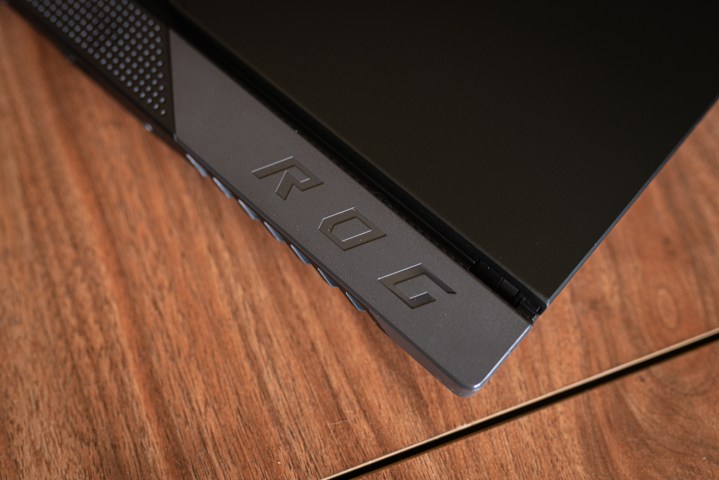
Although AMD has made big strides in gaming laptops over the last couple of generations, Intel has still firmly held the performance crown. That was especially true for Intel’s flagship chips, which AMD didn’t have any clear answer for. The Ryzen 9 7945HX changes that dynamic, and the Strix Scar 17 is a great showcase for the chip.
As a laptop, the Scar 17 is solid as well. The price feels reasonable given the level of hardware inside, even if it means sacrificing in areas like the screen and overall build quality. Even with those sacrifices, you’re getting peak performance in a design that can handle the hardware inside with ease.





